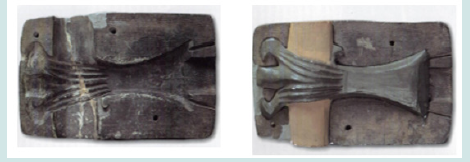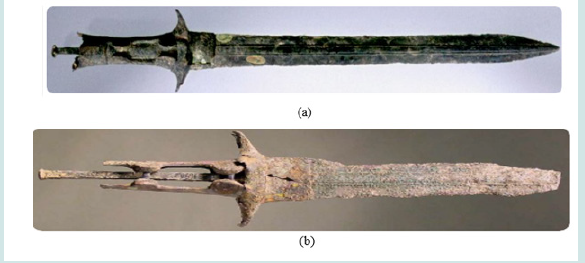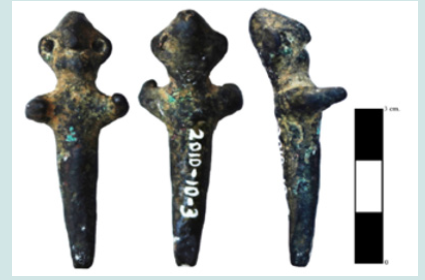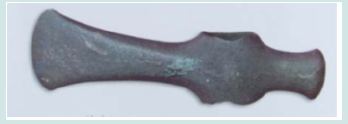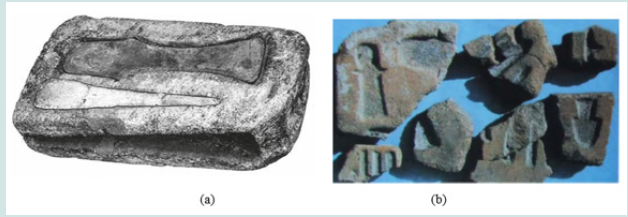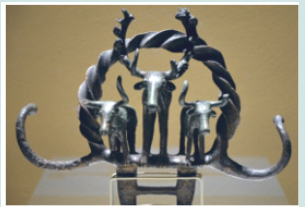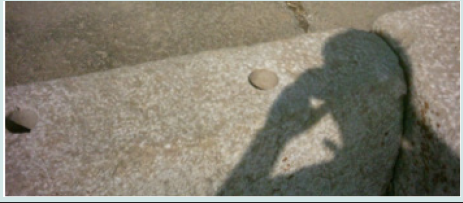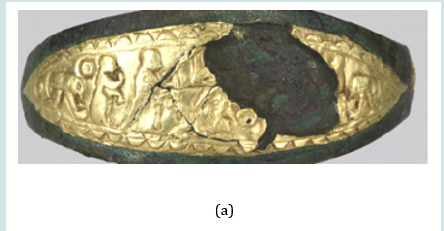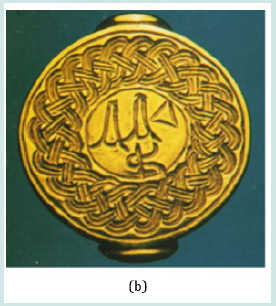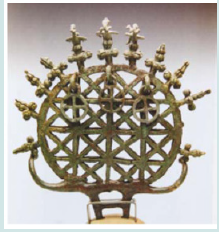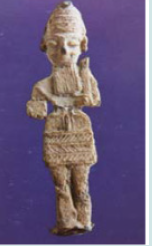
Lupine Publishers Group
Lupine Publishers
Menu
ISSN: 2690-5752
Research Article(ISSN: 2690-5752) 
Mining Processing and Casting in Hittites Volume 9 - Issue 1
Murat Kaya 1*, Gül Kaya2
- 1Dept. of Mechanical Engineering, Hitit University, Türkiye
- 2National Education Institution, Kayseri, Türkiye
Received:February 21, 2024; Published: March 18, 2024
Corresponding author:Murat Kaya, Department of Mechanical Engineering, Hitit University, Türkiye
DOI: 10.32474/JAAS.2024.09.000308
Abstract
Both the Sumerian and Assyrian Trade Colonies in the Mesopotamia region and the trade exchanges between the Hittite royal colonies in today’s central Anatolia region are mentioned in the Hittite tablets. Especially in the last period of the Hittites, the trade of metals as processed or raw materials takes an important among these commercial products. It is known that mines were processed up to 3000 B.C. years. Iron, gold, silver, tin, copper and bronze were processed during the Hittite period. It was seen that obtained as a result of excavations metals were used in the production of swords and various personal objects. They melted the mine, prepared the mold and cast it as desired. When the household items made of clay sludge in the year 4000 B.C. are examined, it is seen that they have knowledge about mold making even before. Objects made from mines were mostly presented to the kings as gifts. The small objects found in the excavations are usually women’s jewelry, combat tools, God statuette casting from different mines. In this study, it was examined how the hittites shaped metal mines by casting method.
Keywords:Hittite Kingdom; Assyrian Trade Colonies; Document of Anitta; Kanish karum
Introduction
Information that sheds light on history is undoubtedly written sources. Approximately 23 thousand clay tablets were found in Kaniş Karum and its surroundings. There is commercial treaty information between Assyrian colonies with colonies of the Hatti country in the vast majority of these tablets. In the light of the information in the correspondence made with tablets at that time was investigated how the mines are processed, what kind of work is done and how the objects are produced.
The colonial states of central Anatolia obtained mines and exchanged goods with Assyrian merchants. Different flow patterns can be distinguished for metals: Copper from Durḫumit and nearby towns the main cities are Kanesh, Waḫšušana and Purušḫattum. Silver and gold came from Waḫšušana and Purušḫattum. For this reason, the Assyrians had to sell their goods in exchange for other goods: for the copper this meant the Duruumit region and for the silver and gold it meant the west. Copper was not the ultimate goal of traders, for those dealing with normal and large-scale copper, for those who were set to the main cities where the ship load was replaced by silver and gold [1].
Casting And Molding
In today’s normal casting mold, if a perforated region is to be made in the part to be cast, the core is placed in the mold. Placed cores are prevented from being displaced in the mold by the effect of mineral melt by core supports. These support cores are melted by the mine and remains in it. (Figure1). Small ax cast from bronze used in ceremonies. Length 19.7 cm. It was found around Ugarit’s palace (https://acikders.ankara.edu.tr/ pluginfile.php/7276/mod_ resource/content/1/Konu%209.pdf). Small ax cast from bronze, not simply poured into a simple engraved mold, mold is prepared in the desired part sizes, it is seen that the perforated parts of the part to be cast are inserted care into the casting mold to provide space Figure 2 [2]. As a result of archaeological excavations, furnaces or casting crucible used for smelting metal were found. It provides information about the size, number, slag waste, temperature, capacity and casting model of the metal ingots found here.
Figure 2: Spade molded ax production. (https://tarihtenfotograflar.blogspot.com/2016/09/anadolu-medeniyetleri-muzesi-4- asur.html.
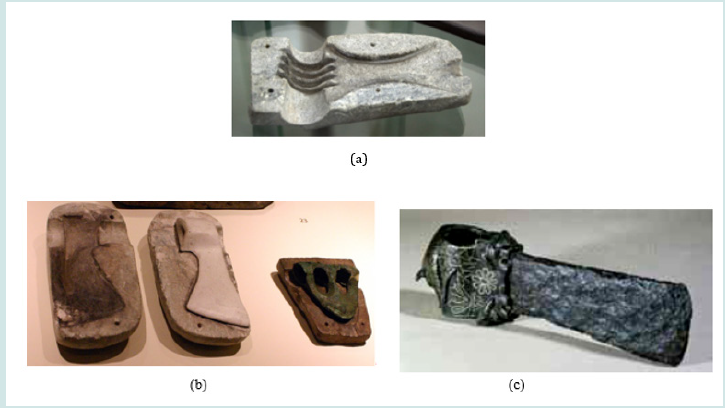
Use Of Metals
Without doubt that with to begin processing of metals, people have shown a new technological development. Social and economic structures have begun to change. These sudden changes have been the limit of technological life. Processing of iron in particular. Sumerian is called ‘wr. an-bar’, Hittite and Hurrians is called Hapalki [3].
According to the inscriptions on the tablet, the raw material was first extracted from foreign materials and then weighed. The molten raw iron ‘An. Bar Kı. Ne’ from the casting crucible was cast into ingots [3].
In correspondence in tablets, the types and kind of metals used are also mentioned. It is understood that each metal is classified according to the degree of purification.
Near Boğazköy Çorum, during the road construction in 1991 sword was found by two the digger operator, (Figure 3). When the sword is examined technically, it is understood that it is produced from hard bronze casting. Four holes have been drilled to hold the handle of the sword. It was also observed that 5 cm of the handle was bent with the help of hammer and there were traces of hammer impact. In the light of the archeological information of the sword, 1430, B.C. It is understood that it belongs to Tudhaliya II. period. The length of the sword from the handle is 70 centimeters, weight 680 grams, and it has the perfect symmetry with regard to technical and processing. From the handle of the sword to the tip, with cuneiform with Akkadian language “ı-nu-ma du-ut-ha-lı-yalugal. gal kur a-as-su-wa u-hal lıQgır an-nu-tım a-naıskur be-li-su u-se-lı” were written. It is written on the sword. ‘When the great king Tuthaliya destroyed the land of Assuwa, he offered this ….. to his lord as a vow to the storm god’. The text writings on the sword are created of embossed letters. It was realized by writing nail embossing letters in the sword casting mold. In order to give strength to the sword, nine support overhang were made on both surfaces from the hilt to the tip. In addition, these I support overhang is get thinner from the grip to the tip. It is cast and processed in a perfectly symmetrical mold.
Figure 3: Sword, Tudhaliya II. period 1430, B.C. (https://arkeofili.com /corumda-3-500-yillik-essiz-hitit-kilici-sergileniyor/).

My guess is that in the early ages, they started with the use of materials with a lower melting temperature. Mines which soften at a certain temperature and take shape easily have been used in object construction. Almost all of these mines obtained from the ground were subjected to melting process as they were found. It is stated that slag formation occurs during melting, decomposition and volume reduction of melt.
ATHE 28: 1um-ma Ša-lim-A-šủ r, 2 Im-di-dingir u Pu-šu-ke-en6, 3 ủ I-li-ba-ni-ma, 4 a-na Ku-zi-zi-a qi-bi-ma 518 ma-na KỦ.BABBAR ku-nu-ki-ka 6 I-li-ba-ni ub-lam 6 GIN 7 i-na ma-ṣa-im im-ṭi 8 1 GIN KỦ.BABBAR a-na na-pá-hi-im 9 u e-ṣi ni-di-in 10 3 2/3 GIN 15 ŠE musu- ka-u 11ku-nu-Ủku-ni i-na E 12 Pu-šuke- en6 i-ba-ši 13 16 1/2 GIN lu ki-ib-sa-tim 14 lu mu-ṭa-u KỦ.BABBAR-ap-ka 15 i-b[i4-t]i-[i]q 16ủ a-m[a-lá] te9-er-ti-ká, 17 a-s.e-er 18 ma-na kủ babbar [4].
Three-day work of 300-400 workers and the shearing of sheep are mentioned in one sentence of the letter to the king of Mari Yasmah-Addu. (ARM 5, 67): It is understood that cutting tool made of metal is used to shear the wool of sheep. Many objects and swords made of cast bronze and cast silver were found in the Çorum Alaca mound. (Figure 4, Figure 5).
Figure 4: (a) Bronze casting deer. Hitit, 1900 B.C. Victoria and Albert Museum. (https://collections.vam.ac.uk/item/O1290972/ hittite-silver-bull-found-in-photograph-unknown/) (b) Silver ornate bronze deer Alacahoyuk Museum Of Anatolian Civilization. (https://tarihvearkeoloji.blogspot.com/2014/03/ alacahoyuk.html).

Early Hittite Period 18-16. B.C. centuries the votive nails, which are estimated to be between were made by casting (Figure 6). There are two structure votive nails numbered 2010.10.3, 2013.17.9 in the inventory of the Archeology Museum of the Konya Museum Directorate. ([5] Figure 6).
An ax made of cast arsenic copper was found in Samsun excavations. It is believed that cores are used in the casting (Figure 7) mold to form the handle hole of the ax.
Urş kārum’u sent a letter to Kanish kārum’. It tells us that the temple of God Asshur in Urus was robbed. In the lines 6 to 12 of the letter, It was talk about of the golden sun (ascension) in the chest of God Asshur and the dagger of Asshur. It is also believed that the materials mentioned in lines 13 to 17 are kalubu, samru’ātum and katappu valuable objects stolen.
ša-ru-qu a-na E-ti dA-šur 7 e-ru-bu-ma ša-am-ša-am 8 ša GUŠKİN 9 ša i-ir-ti dA-šur 10 u pa-aṭ-ra-am 11 ša d A-šur 12 [x x] a u mi-šu-ru-um 13 ka-lu-bu-u 14 sa-am-ru-a-tum 15 u ka-ta-pu 16 ta-ab-lu E-tum 17 la-quut mi-ma la e-zi [bu]. [6].
A large number of lead figurines and stone molds were found in Kārum in Kultepe (Figure 8). It was also found that lead ingots in a foundry workshop ([7] Figure 8).
In the first half of the Bronze Age, an open cast mold was used. After casting, the parts are formed into desired shape by forging. A series of Hatti bronze objects found among the grave goods in the tombs at Alacahöyük, a Hittite settlement in the province of Çorum in Anatolia (Figure 9).
While the build stone walls of the Hittite palace in Alacahöyük, two holes with a diameter of 3 cm and a depth of 25 cm were drilled on each surface of the overlapping stones. It is thought that the strength of the walls is increased by placing opposite metal into these holes. (Figure 10) Hole drilled into the foundation Stone. ([8] Figure10).
Believing in God was as important in the Hittites as it was in every society. For this reason, they made the god and goddess figurines which they value very much by casting technique.
During the excavations in Kültepe, king Anitta’s dagger made of bronze was found (Figure 11). Dagger is in the Museum of Anatolian Civilizations. On the side surface of the dagger is written ‘the palace of King Anitta’. “E GAL A-ni-it-ta ru-ba-im” (https:// arkeokur.tumblr.com/post/13010044577/kral-anittanın-laneti)
Many mines were found in Anatolia. Copper was brought from Durḫumit and towns in its surroundings to the major cities, Kanesh, Waḫšušana and Purušḫattum. Silver and gold came from Waḫšušana and Purušḫattum [9]. Some Metals Which Assyrian and Anatolian Traders Mutual Exchange.
Iron
The parzillum iron found in Alacahöyük shows that Iron has been known in Anatolia since 3 thousand years B.C. [10]. The name of the iron is AN. BAR in Hittite tablets.
Kültepe tablets (3, 97) mention the ring made of iron. ‘….. ṭuppu- um 21 ša. ma-na KU. BABBAR u a-nu-qu-um 22 ša par-zi-li-im ša hu-bu-ul 23 Ta-ki-il-A-šur.’
It is also understood that there is an organization like blacksmiths head (rabi nappāhē) in the Kanish.
The king wants iron from Hattušili III (1280-1250 BC). Hattušili III writes to king in his letter as follows. ‘As for the quality iron you wrote me; There is no good iron in the production workshop shop in Kizzuwatna. I have already written that it is not suitable to produce good iron. Those who will produce iron have not finished yet. I will send it to you when the product is finished. Now I’m sending you an iron dagger [11].
In addition, mentioning iron types such as black iron (AN.BAR GE6), white iron (AN.BAR BABBAR), and good iron (AN.BAR SİG5) shows that they decompose iron ore.
It is understood that iron is melted and processed, they are able to cast in a volume sufficient to make a throne, and they are capable of directing iron in a skillful manner to make a scepter.
79 lines of King Anitta Texts were found during the excavations at Boğazköy-Hattuşaş. In lines 74 and 75, the Purushhanda man brought me his presents. He brought me an iron throne, an iron cane as a gift. ‘ nu LÚ URUPu-ru-š-ḫa-a[(n-da kat-ti-mi ḫe-en-ku-m) u-uš. šū-mu GIŠŠÚ. A AN.BAR PA.GAM AN.BAR (ḫé-en-gur ú-da-aš)’, u-uš. šū-mu GIŠŠÚ. A AN.BAR PA.GAM AN.BAR (ḫé-en-gur ú-da-aš)’, [12].
Gold
The gold melting temperature is 1.064 0C. Gold was used as the most important trading tool at that time. Barter was made when necessary. A correspondence between the two Assyrians.
“As for this 1/3 mina silver that Puzur-Anna paid me, In Hahhum, the seraglio melted him and turned him into silver. ….. Please, he will pay you the gold, you put it on fire twice......”
Pa 17: 3….1/3 ma-na GUŠKİN 4 ša Puzur4-A-na 5 iš-qu-la-ni i-na 6 Ha-hi-im E.GAL-lum 7 iṣ-ru-up-šu-ma a-na 8 KU. BABBAR-pi-ma i-tu-ar 9 u5 u4-me u-ša-as-hi-ri 10 u 10 GIN KU.BABBAR 11 ra-aqqu- tim 12 i-na ṣe-ri-a 13 il5-te-qe…………..20 a-pu-tum a-pu-tum 21 GUŠKİN ša i-ša-qa-la-ku-ni 22 a-na i-ša-tim 23 ši-ni-šu ta-er-šu…… [13]. Assyrians gave great importance to gold. Kaniş has written an ultimatum on the transportation of gold from Anatolia to Assyria. There must be a time when the Assyrian king was strong.
In Kt. 79/k 101: 1 um-ma wa-ak-lum-ma 2 a-na ka-ri-im 3 Kani- iški 4 qi-bi-ma ṭup-pa-am 5 ša di-in a-limki 6 ša a-šu-mi KU.Gİ 7 ša ni-iš-pu-ra-ku-nu-ti-ni 8 ṭup-pu-um šu-ut a-ku-uš 9 a-šu-mi KU.Gİ i-ṣuur- tam 10 u-la ne-ṣu-ur 11 a-wa-tum ša KU.Gİ 12 pa-ni-a-tum-ma 13 a-hu-um a-na a-hi-im 14 a-na ši-mi-im 15 i-da-an 16 ki-ma a-wa-at 17 na-ru-a-im 18 DUMU A-šur šu-um-šu 19 KU.Gİ a-na A-ki-di-im 20 A-muri- im 21 u Šu-bi-ri-im 22 ma-ma-an 23 la i-da-an 24 ša i-du-nu 25 u-la i-ba-la-aṭ
‘1-4 Waklum says to Kaniş kārum. 4-8 The tablet about the decision of Assyrian city we sent to you about gold; This tablet has been canceled. 9-10 We didn’t detect any decisions on gold. 11-12 The previous decision on gold is still valid. 13-15 Assyrians can sell gold among themselves. 16-23 But according to Stelin’s words, no one Assyrian will sell gold to Akkadian, Amurrulu or Subarli. 24-25 Whoever does this won’t stay alive’, [3-15]
Figure 12: (a)-(b) Seated goddess with a childca. 14th–13th century B.C. in the Metropolitan Museum of New York.
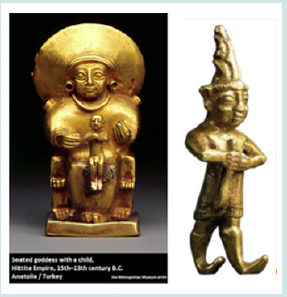
The belief in God is very important for the Hittites. Therefore, they prepared a casting mold without avoidance any details of the physical appearance of the gods and goddesses they perceive. They melted the gold and casting it into the mold. On her lap the goddess holds a naked child, cast separately of solid gold and then attached (Figure 12). Dimensions: H. 4.3 cm, W. 1.7 cm, D. 1.9 cm. The Hittite god statue made of gold is on display in the Metropolitan Museum of New York [16]. Gift of Norbert Schimmel Trust, 1989
Figure 13) A farmer living in Çitli village of Çorum’s Mecitözü district found an object in his field. The offering of the Hittite king to the god is depicted on the gold bracelet, which belongs to the Hittite period (Figure 15). (https://arkeofili.com/corumda-bulunannadir- hitit-bilezigi-muzede-sergiye-alindi/)
Silver
Silver was melted in furnace ladles and cast in certain molds and weights. It has the lowest melting temperature compared to other metals and is the most processed metal. Silver mines are mostly used in trade. The Hittite merchants used the silver mine as well as the other mines. It was used both as money in the purchase of the goods they needed, as well as exchange with other mines and in exchange for debt.
The trade with Assyrian traders is mostly mentioned on tablets. In a letter in Kaniş, they write that they undergo certain processes in order to make silver pure.
Ilī-bāni brought 18 mina (9 kg) of silver here under your seal. During the purification (process) 6 şeqel decreased. We paid 6 shekels for the miner and the wood. 3 2/3 şeqel 15 ŠE (silver) is located in Pũşukēn’s house under our slag seal. Your silver is both incomplete and lost, (so it’s) reduced 16 şeqel
ATHE 28: 1um-ma Ša-lim-A-šủ r, 2 Im-di-dingir u Pu-šu-ke-en6, 3 ủ I-li-ba-ni-ma, 4 a-na Ku-zi-zi-a qi-bi-ma 518 ma-na KỦ.BABBAR ku-nu-ki-ka 6 I-li-ba-ni ub-lam 6 GIN 7 i-na ma-ṣa-im im-ṭi 8 1 GIN KỦ.BABBAR a-na na-pá-hi-im 9 u e-ṣi ni-di-in 10 3 2/3 GIN 15 ŠE musu- ka-u 11ku-nu-Ủku-ni i-na E 12 Pu-šuke- en6 i-ba-ši 13 16 1/2 GIN lu ki-ib-sa-tim 14 lu mu-ṭa-u KỦ.BABBAR-ap-ka 15 i-b[i4-t]i-[i]q 16ủ a-m[a-lá] te9-er-ti-ká, 17 a-s.e-er 18 ma-na kủ .babbar. [17]
The quality of silver was determined by the Assyrian administration in Kanish. Indigenous people used among themselves low-quality (litum) silver. However, they used purified silver (şarrupum) between them and Assyrians.
Kanish to Asura: about 360 kg to 9 people in one tablet. In the other 540 kg. to 8 people silver has been posted. [18]
Another tablet (Kt. 91/k 522) mentions that silver is used for shopping.
E ša İštar-la-ma-si 2 u A-šur-DUG 3 a-na 2 ½ ma-na 4 KU. BABBAR a-na 5 Ša-lim-ma i-di-nu-ma 6 KU.BABBAR ši-im E-šu-nu 7 A-šur-DUG İštar-la-ma-si 8 ša-bu-u
İştar-lamassī and Aşşur-tāb sold their own house to Selman for 2 ½ mina silver. Aşşur-tāb and İştar-lamassī agreed to sell their homes for the silver they want. [19].
Cupper
Copper is the leading commodity trade among the Assyrian merchants with the colonies of central Anatolia. The central Anatolian colony centers where copper is obtained are Haburāta, Ishtanuwa, Kunanamut, Shawit, Tapashatta, Taritar, Tishmurna, Tuhpiya, Purushhattum, Washhaniya and Neneshsa [20].
It is also mentioned in a tablet that good copper is sold to Kaniş Karum.
‘4 talent fine copper and 2 talent 30 mina copper free of hematite from Taritar; a total of 6 talent copper Imdilum Salia’s son Idnāya’dan creditor. From the week of Iddi (n) -Su’en’s son Alāhum and Ennam- Anum, Imdilum will send his son to Turhumit. Copper will be delivered to Kaniş until harvest’.
ICK 2, 54: 1 [ 4 GU] URUDU SİG5 2 [ša T]a-ri-ta-a[r] 3 [2] GU 30 ma-na URUDU 4 [ša] ša-ad-wa-na-am 5 la u-ka-lu 6 ŠUNİGİN 6 GU 30 ma-na 7 i-ṣe-er 8 İd-na-a-a 9 DUMU Za-li-a 10 İm-di-DINGIR i-šu 11ištu ha-muš-tim 12 ša A-la-hi-im 13DUMU İ-di-Su-en6 14u E-na-ma-nim 15İm-di-lum a-na 16 Tu-ur-hu-mi-it 17ṣu-ha-ar-šu / i-ša-par 18a-na Kani- iš / a-na 19ni-ga-li-im URUDU 20 u-ša-ak-ša-dam šu-ma 21[la] uš-taakši- dam 22 [ki-m]a a-wa-at 23 [ka-ri-im 1 1/2 ma]-na. TA 24[ṣi-ib-tam a-na] 251 GU.tim / u-[ṣa-ab] (witnesses) [21].
In some lines of a letter written from Assyria to Anatolia are written as follows. The market is suitable for copper in Purushhattum. We could not rent a car and could not bring the copper to Purushhattum. Send the donkeys here. We will bring his copper to Purushhattum.
TC 2, 18: 7…… ki-ma URUDU-i-u 8 i-na Pu-ru-uš-ha-tim 9 ma-ah- ṣu-ni i-re-qam 10 la ni-gu5-ur-ma 11 a-na Pu-ru-uš-ha-tim 12 la lu-šeri- ib 13 e-ma-ri-i še-ri-a-ma 14 URUDU-u-šu a-na Pu-ru-uš-ha-tim 15 lu-še-ri-ib [22]
It is written on a tablet. 32. A large number of Ebla came here and (a large amount) of copper was weighed for them in the palace. They paid (1 ’şeqel) ammurum silver for each 2 1/3 mina copper. 32 [18].
ATHE 32: 15 a-na urudu [ši’]-ki-im, 16 15 ma-na.TA a-d [ i-m] a, 17
urudu i-ba-si eb-la-i- u’, 18 ma-
‘My caravan will be leaving in 10 days. When it comes to their stay here for a long time; The palace and its officers owe me 24,000 mina (400 talent) copper, and now unfortunately they are in sikkatum.’
‘Kt. a/k 583b: 5a-di 10 u4-me-e ha-ra-ni u-ṣi-a-am 6a-na ša u4- me-e ma-du-ti-im 7 a-na-kam uš-bu-ni 24 li-me 8URUDU E.GAL-lum u te-ra-tu-šu 9i-hi-ib-lu-nim-ma la li-bi i-li-ma i-na si-ka-tim 11[ušbu- m] a
On another tablet:
‘As for the copper of the palace; An illness haunted me and I was late. They have kept us waiting until today and I’m fine, don’t worry. I will wait five days and if the copper of the palace is not ready, I will take my weapon and go to Purushhattum’...
TC 3, 25: 6 URUDU ša E.GAL-lim a-di 7 u-mi-im a-ni-im 8 i-ta-na-pulu- ni-a-ti 9 u i-a-ti mu-ur-ṣu-um 10 im-qu-tam-ma 11 a-di a-ni a-su-huur 12 ša-al-ma-ku 13 mi-ma li-ba-ka 14 la i-pa-ri-id 15 a-di u-me u-taqama 16 šu-ma URUDU ša 17 E.GAL-lim la i-ta-ṣa-am 18 ka-ki a-la-qe-ma 19 a-Pu-ru-uš-ha-tim 20 a-ta-la-ak [24] .
In a text: ‘It corresponds to 75 pieces of tunc belong to Assyrian named -emũqī, consisting of kitchen utensils, vases, lamp, knife and mirror with a total weight of 1 talent 17 mina‘. [25] Kt. c/k 1517:)
Another tablet: ‘A list of 78 bronze articles weighing a total of 1 talent 40 mina is given’. Kt. h/k 82 [26]
Another tablet: ‘I want to bring the copper to Purushhattum before the country enters harvest time20’.
TC 3, 3:’ 9 …………. a-na Wa-wa-li 10 um-ma a-na-ku-ma 11 e-re-qatim iš-ti 12 E.GAL-lim e-ri-iš-ma 13 a-di şu-ha-ru i-ma-qu-tu-ni-ni 14 lu er-su-wa 15 a-pa-ma la i-da-nam 16 u a-na E.GAL-lim a-di-i 17 e-re-qatim la i-qa-bi-ma 18 e-re-qa-tim la nu-še-ša-ar 19 a-na-kam we-daku 20 i-hi-id-ma te-er-ta-ka 21 ar-hi-iš li-likam- ma 22 la-ma ma-tam e-ṣa-dum 23 iṣ-bu-tu4 URUDU a-na 24 Pu-ru-uš-ha-tim 25 lu-še-ri- ib’. (Tablettes cappadociennes du Louvre, Paris) [27].
Kt. c/k 254 states that a car was rented in exchange for 20 mina copper in order to bring 20 talent (600 kg.) copper from Wahşuşana to Puruşhattum. In (Kt. 87/k 436): 14 talent 5 mina copper, was sent to Wahshushana by car. [28]. An object made of cast Arsenic Copper found in Çorum Alaca mound (Figure 14).
Lead Mine
Lead is the most widely used metal in the casting method of objects with its ability to melt easily. The name Lead (abārum) in tablets is mentioned in only a few texts. It is thought to be abundant compared to other metals. It is understood traders do not make much profit than lead trade. As a result of mixing lead and copper melt, they obtained harder bronze than both.
In one text (AKT 1, 30) it is said: I heard that he went to Hurama, but there was nothing but bullet. 54: 12…….. aš-me-ma 13a-na Hu-rama e-ti-iq-ma 14 a-la-an a-ba-ri-im mi-ma 15 ša-ni-im la-šu. [29].
Tin
It is also known that silver was purchased from the Hittite merchants to Assyrian countries, tin is purchased from merchants coming from the Assyrian country to the Hittite country. (on Tablet Kt. n/k 794)
It is understood that the Assyrian and Anatolian colonies mine traded between them and they paid taxes on a certain percentage of the mine. The mines were of great economic value. For this reason, the mine packages were sealed during transportation [30].
The mines were also a valid currency when shopping. In addition, along with the caravan head along the way, he kept some tin (annak qātim) for daily expenses.
In a text it is written as a road tax:
‘Like your father, you’il get 12 şeqel tin from each caravan coming up. Like your daddy, you’re gonna to eat 1 şeqel of silver per donkey that goes down. You won’t get anything more’.
‘Like your father, you’il get 12 şeqel tin from each caravan coming up. Like your daddy, you’re gonna to eat 1 şeqel of silver per donkey that goes down. You won’t get anything more’.
‘Kt. n/k 794:’ 17 ki-ma a-bi-ka-ma 18 i-na e-li-tim 19 e-li-tim 12 GIN. TA 20 AN.NA ta-la-qe i-na 21 wa-ri-ti-im 1. GIN.TA KU. BABBAR 22 i-na e-ma-ri-im 23 ki-ma a-bi-ka ta-ka-al 24 wa-at-ra-am mi-ma 25 la ta-laqe’….
In another letter;
As for the merchant silver that Kusia brought, the caravan from the Lower Country has been delayed and there is no tin trading here. If the caravan comes from the Lower Country, I will buy fabric and tin according to decision of the city (the Assyrian) and send it to you immediately’
AKT 3, 74:’ 3…….…KU.BABBAR 4 ša DAM.GAR ša Ku-ṣi-a 5 ub-la-ni h[a- r]a-num ša ma-at 6 ša-pi-i[l5-t] im ša-da-at 7u a-na-kam ši!-mi AN.NA u-la 8 i-ba-ši šu-ma ha-ra-num 9 ša ma-at ša-pi-il5-tim 10e-taarba- am ma-la 11 di-in a-limki AN.NA 12 u TUG.Hİ.A / a-ša-a-ma 13 i-pa-nim-ma u-še-ba-la-ku-nu-ti ‘[32].
The caravan coming from Assyria is mentioned in AKT 3, 73: 21-30. It is mentioned that one third of the 33 mina silver belonging to the merchant will be bought tin.
The kings were also interested in mining trade. ‘Şũ-Nũnu brought you 5 mina tin under my seal. Send me the silver from the sale of my tin. Don’t accept a low price. I will pray to you in the presence of God Ashshur and my own god’.
VAT 9825: 6 5 ma-na AN.NA 7 ku-nu-ki-a Šu-Nu-nu 8 ub-la-kum ši-im 9 AN.NA-ki-a KU. BABBAR 10 še-bilam 11 [la] ta-ba-ta-qam 12 [İGİ] A-šur 13 u i-li-a 14 a-ka-ra-ba-ku-nu-ti [33].
In another letter the king;
‘Ennum-Aşşur brings you 6 talents and additional tin, 12 windings (in pieces) fabric and 3 black donkeys. You are my sons. There (in Kaniş), as if it is your own business and buy my tin. Don’t wait for Aduda. Buy the tin as the current shelf there. Get the silver to Aduda. I will pray for you in the presence of God Ashshur and my own god’.
AKT 2, 22:’ 5 6 GU u it-ra-su 6 AN.NA 12 TUG ša li-wi-tim 7 3 ANŠE
ṣa-la-me En-um-A-šur 8 i-ra-di-a-kunu- ti 9 me-er-u-i-a a-tu-nu 10
a-ma-kam ki-ma a-ra-ma-na-ti-ku-nu 11 tu-us-ta-ma-ra-ṣa-ni 12
AN.NA-ki di-na 13 A-du-da la tu-qa-a-a 14 AN.NA 1/2 GIN zi-
Result
Anatolia has been home to many civilizations. In the central Anatolian region where the Hittites lived, It was mentioned how the mining trade was done between the Hittites and the Assyrian colonies. The most traded main mines are mentioned. How these metals are melted, poured into preformed molds, It is described in writing on hitit tablets. It is understood from these mines that they made objects, ornaments, jewelry and weapons. Some minerals mixed with each other to a certain extent and melted. For example: They were able to discover Bronz and made war tools out of it like swords and axes by casting.
Symbols
ATHE: Die Altassyrischen Texte Des Orientalischen Seminars Der Universitat Heidelberg Und Sammlung Erlenmeyer Basel
AKT: Ankaraner kültepe- texte
ICK: Inscription cuneiformes de kültepe
TC: Tablettes cappadociennes du louvre
Kt. a/k: Excavation inventory numbers of tablets found in Kültepe.
References
- Dercksen J G (2006) The Assyrıan Colony at Kanesh’ 6. Internationales Colloquium der Deutschen Orient-Gesellschaft pp. 22-24.
- Fathalizadeh A (2012) Eski Çağda Demir Üretim, Teori Ve Teknolojisi’ Metalürji p. 57.
- Sever H (1990) Yeni Kultepe Tabletlerinde Gecen ‘kīma awāt naru’āim’ Tabiri ve Değerlendirilmesi”, DTCFD 34(1): 251-265.
- Kienast B (1960) Die Altassyrischen Texte des Orientalischen Seminars p. 26’ der Universitat Heidelberg und der Sammlung Erlenmeyer (Basel, Berlin).
- Özcan A, Akgün E (2016) İki Hitit Yapı-Adak Çivisi’ Archıvum Anatolıcum (Aran) pp. 47-54.
- Larsen M T (1976) OACC: The Old Assyrian City State and its Colonies, Mesopotamia 4, Copenhagen pp. 261-262.
- Özgüç T (2005) Kultepe, Kaniš/Neša, İstanbul p. 217.
- Kaya M (2010) Alacahoyuk, Photograph
- Dercksen J G (1996) The Old Assyrian Copper Trade in Anatolia, PIHANS. Leiden, İstanbul p. 184.
- Yalcın Ü (2006) Hititlerde Demir, Uluburun Gemisi, 3000 Yıl Once Dunya Ticareti pp. 495-505.
- Goetze A (1940) Kizzuwatna and the Problem of Hittite Geography, New Haven p. 29.
- Kemal Ö
- Larsen M T (2002) The Aššur-nādā Archive, Old Assyrian Archives, Volume 1, PIHANS 96, İstanbul, pp. 97.
- Veenhof K R (2008) The Death and Burial of Ishtar-Lamassi in Kārum Kanish, Festschrift Marten Stol pp. 97-119.
- Veenhof K R (1995) In Accordance with the Words of the Stele, Evidence for Old Assyrian Legistlation Chicago-Kent Law Review 70(4): 1717-1744.
- Koç İ (2006) Hititler ODTÜ Bilim ve Toplum Kitapları Dizisi ISBN 978-9944-344-09-5 Ekim 2006 Semih Ofset Matbaacılık Yayıncılık ve Ambalaj San. Tic. Ltd. Ş
- Kienast B (1960) ATHE: Die Altassyrischen Texte des Orientalischen Seminars der Universitat Heidelberg und der Sammlung Erlenmeyer p.39.
- Dercksen J G (2005) Metals According to Documents from Kultepe-Kanish Dating to the Old Assyrian Colony Period, Anatolian Metal III p. 1-21.
- Veenhof K R (2003) Three Unusual old assyrian Contracts: Festschrift fur Burkhart Kienast 62 (512): 693-705
- Dercksen J G (1996) The Old Assyrian Copper Trade in Anatolia’, PIHANS. Leiden, İstanbul p. 15.
- Dercksen J G (1996) The Old Assyrian Copper Trade in Anatolia, p.184, PIHANS. Leiden, İstanbul.
- Dercksen J G (1996) The Old Assyrian Copper Trade in Anatolia, PIHANS. Leiden, İstanbul p. 200.
- Kienast B (1960) ATHE: Die Altassyrischen Texte des Orientalischen Seminars der Universitat Heidelberg und der Sammlung Erlenmeyer’. p 47.
- Dercksen J G (1996) The Old Assyrian Copper Trade in Anatolia’, PIHANS 75. 2004 Old Assyrian Institutions p. 205.
- Dercksen J G (1996) The Old Assyrian Copper Trade in Anatolia’ p. 76.
- Dercksen J G (1996) The Old Assyrian Copper Trade in Anatolia’ p. 77.
- Günbattı C (2012) Kültepe-Kaniş/Anadolu’da İlk Yazı, İlk Belgeler’, Kayseri: Kayseri Büyükşehir Belediyesi Kültür Yayınları, 104.
- Günbattı C (2012) Kültepe-Kaniş/Anadolu’da İlk Yazı, İlk Belgeler, Kayseri, 105. Kayseri Büyükşehir Belediyesi Kültür Yayınları.
- Günbattı C (2012) Kültepe-Kaniş/Anadolu’da İlk Yazı, İlk Belgeler, Kayseri Büyükşehir Belediyesi Kültür Yayınları 77.
- Veenhof K R (1972) (AOATT) Aspects of Old Assyrian Trade and its Terminology’, Leiden, 30-33.
- Günbattı C (2012) Kültepe-Kaniş/Anadolu’da İlk Yazı, İlk Belgeler, Kayseri Büyükşehir Belediyesi Kültür Yayınları 72.
- Günbattı C (2012) Kültepe-Kaniş/Anadolu’da İlk Yazı, İlk Belgeler, Kayseri Büyükşehir Belediyesi Kültür Yayınları 72.
- Larsen M T (1976) OACC: The Old Assyrian City State and its Colonies, Mesopotamia 4, Copenhagen, 141-142.
- Günbattı C (2012) Kültepe-Kaniş/Anadolu’da İlk Yazı, İlk Belgeler, Kayseri Büyükşehir Belediyesi Kültür Yayınları 72.
- Başak O (2008) Taş Çaği’ndan Tunç Çaği’na Anadolu’da Maden Sanatin Gelişimi Ve Kullanimi, Cilt 0, Number 21(1): 15-33.
- Bilgi Ö (2004) (a) (b), Pre-Classical Age / Klasik Çağ Öncesi”, Anatolia, Cradle of Castings Anadolu, Dökümün Beşiği, İstanbul.
- Bingöl F R I (1999) Antik Takılar: Anadolu Medeniyetleri Müzesi, Ankara: T.C. Kültür Bakanlığı Anıtlar ve Müzeler Genel Müdürlüğü
- Çeçen S, Hecker K (1993) Ina mātika eblum, Zu einem neuen Text zum Wegerecht in der Kultepe-Zeit, Festschrift fur W. von Soden zum 85. Geburtstag am 19. Juni 85- 31-41 Dercksen J G (2008) The Assyrıan Colony at Kanesh p. 115.
- Mazow L B (2017) A Weaving Sword at Miletus? Combat or Weaving Sword and the Complexities of Gender Construction. p. 4., Archaeological Textiles Review p.59.
- SavaşS Ö (2006) ‘Çivi yazılı Belgeler Işığında Anadoluda (M.Ö. 2. bin yılında) madencilik ve maden kullanımı’ - Türk Tarih Kurumu, Ankara.

Top Editors
-

Mark E Smith
Bio chemistry
University of Texas Medical Branch, USA -

Lawrence A Presley
Department of Criminal Justice
Liberty University, USA -

Thomas W Miller
Department of Psychiatry
University of Kentucky, USA -

Gjumrakch Aliev
Department of Medicine
Gally International Biomedical Research & Consulting LLC, USA -

Christopher Bryant
Department of Urbanisation and Agricultural
Montreal university, USA -

Robert William Frare
Oral & Maxillofacial Pathology
New York University, USA -

Rudolph Modesto Navari
Gastroenterology and Hepatology
University of Alabama, UK -

Andrew Hague
Department of Medicine
Universities of Bradford, UK -

George Gregory Buttigieg
Maltese College of Obstetrics and Gynaecology, Europe -

Chen-Hsiung Yeh
Oncology
Circulogene Theranostics, England -
.png)
Emilio Bucio-Carrillo
Radiation Chemistry
National University of Mexico, USA -
.jpg)
Casey J Grenier
Analytical Chemistry
Wentworth Institute of Technology, USA -
Hany Atalah
Minimally Invasive Surgery
Mercer University school of Medicine, USA -

Abu-Hussein Muhamad
Pediatric Dentistry
University of Athens , Greece

The annual scholar awards from Lupine Publishers honor a selected number Read More...




